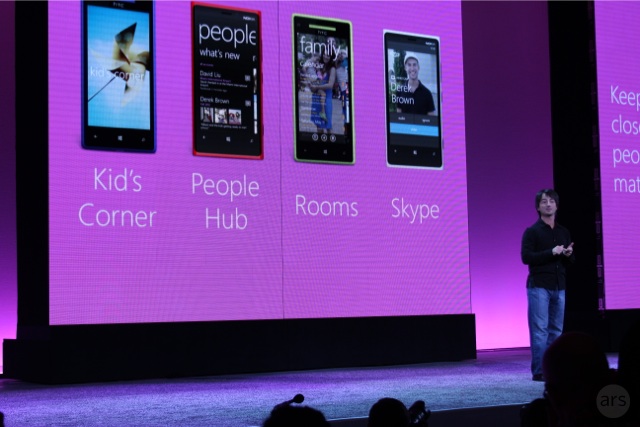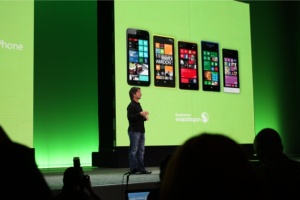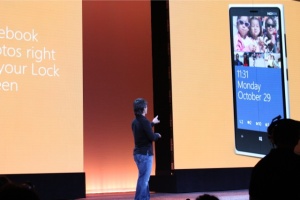Microsoft has been aiming big lately and in order to excel they’ve been launching products with differentiation as the key aspect.
First in line is the upgrade to Windows 7, called Windows 8, without doubt it’s a great OS, yes; it works fluidly and brings lots of new things on-board. The new app ecosystem, if matures can make the devices powered by Windows 8 a unique blend for consumers. Microsoft even took a bold decision to launch its own slate (Surface) by keeping its OEM partners at bay. Today, Surface RT (regardless of its inability to handle older Desktop apps) is selling hot, preorders definitely suggest so and certainly Microsoft has found a winning combination with Surface and Windows 8.
So let’s come to the product which is second in-line, software for your smartphone, aka Windows Phone 8.
While Google cancelled its event owing to Hurricane Sandy, Microsoft glued the audience with a killer presentation of its Smartphone OS. Microsoft event started at 10.30PM IST, though I didn’t attend the event but the live webcast simply served the purpose.
Read past the break to know what the big deal in Windows Phone 8 is.
HARDWARE: It’s all about hardware these days. From Engineering to material innards, hardware has been the talking point. While Apple has pioneered in Engineering, Android has raised the bar when it is about hardware innards. From quad-core processors to gigantic screens, today smartphone have it all and Windows Phone8 joins the party right now.
Great phones are coming with Windows Phone 8 platform. Yes, from the likes of HTC, Nokia and Samsung, both in terms of design and capabilities.
- Multiple cores: WP8 now supports anywhere from two cores to 64. Devices launching now will be christened with dual-core Snapdragon S4 processor. Quad-core should come sometime at the end of this year/early next year.
- Screen resolution: The only display resolution we know from WP7 is WVGA, or 800 x 480, way behind Android/iPhone’s display technologies. With WP8, this hurdle is overcome. Windows Phone 8 devices can now support one of three options: WXGA (1,280 x 768), 720p (1,280 x 720) and the old-fashioned WVGA standard (ideal for entry-level smartphones).
- Expandable storage: Windows Phone 8 fully supports external storage up to SDXC, allowing you to add as much as 64GB in additional memory. Sadly, Nokia’s Lumia 920 and HTC Windows Phone 8X don’t offer memory expansion.
- NFC: Although NFC is not new for Windows Phone, it came as a software stack up on OS with Lumia 610 NFC but with Windows Phone 8, there is full native support for Near-Field Communications.
Just as it’s done in the past, Microsoft has offered up a list of hardware requirements for each phone to run Windows Phone 8. The list includes:
| Minimum Windows Phone 8 device requirements |
|---|
| Qualcomm Snapdragon S4 dual-core processor |
| Minimum 512MB RAM for WVGA phones; minimum 1GB RAM for 720p / WXGA |
| Minimum 4GB flash memory |
| GPS and A-GNSS; GLONASS is supported if OEMs decide to include it |
| Support for micro-USB 2.0 |
| 3.5mm stereo headphone jack with three-button detection support |
| Rear-facing AF camera with LED or Xenon flash, optional front-facing camera (both need to be VGA or better) and dedicated camera button |
| Accelerometer, proximity and ambient light sensors, as well as vibration motor (magnetometer and gyroscope are optional) |
| 802.11b/g and Bluetooth (802.11n is optional) |
| DirectX graphics hardware support with hardware acceleration for Direct3D using programmable GPU. |
| Multi-touch capacitive touch screen with minimum of four simultaneous points |
An all new START: Yes, Microsoft has given its Metro (Modern UI) based screen an all new start. In this new Start Screen, Live Tiles extend all the way to the right edge of the screen, adding more screen real-estate to each tile. Live Tiles now come in three sizes. Now the smaller tile in WP7 goes medium, thus giving you more customization option. Just think of your most important people’s updates being pinned to Start Screen as smaller tiles and an important Office document being pinned to take a larger screen estate. All sounds cool and visually resounding. You can change the sizes of these live tiles by simply long-pressing the tile and a new arrow shows up in the bottom-right corner. This idea of adding more viewable content to the Start screen is a win for me.
Lockscreen: Most intuitive UI on mobile devices now offers most elegant Lockscreen (not everyone will agree though) delivering live updates via Live Apps.
 Lockscreen can deliver live updates of your most recent unread email, text message or missed call. Now, notifications on the bottom of the screen offer five icons, all of which support third-party apps. The best part is you can decide what type of updates you receive and even arrange them on the basis of preference from left to right. The lock screen background can also be dynamically updated to display third-party app information like breaking news updates from CNN or Bing Photo of the day or your Facebook Photoroll. All sounds really cool.
Lockscreen can deliver live updates of your most recent unread email, text message or missed call. Now, notifications on the bottom of the screen offer five icons, all of which support third-party apps. The best part is you can decide what type of updates you receive and even arrange them on the basis of preference from left to right. The lock screen background can also be dynamically updated to display third-party app information like breaking news updates from CNN or Bing Photo of the day or your Facebook Photoroll. All sounds really cool.
Apps? Top Apps: Microsoft emphasized on their plans of bringing only the top apps to their ecosystem yes, I don’t care about the no. of apps but Quality apps truly matter.
 For the first time ever, the new Skype app is always on. It’s ready to receive a call or message at any time, and it does this without running code in the background and draining your battery. Soon the Likes of Temple Run, Jetpack Joyride, Angry Birds Star Wars, Angry Birds Space, Draw Something, Words with Friends, Urban Spoon, Fairway Solitaire, Asphalt 7: Heat, Living Social, Cut the Rope, and Where’s My Water and Where’s My Perry from Disney will have their own Live Tiles.
For the first time ever, the new Skype app is always on. It’s ready to receive a call or message at any time, and it does this without running code in the background and draining your battery. Soon the Likes of Temple Run, Jetpack Joyride, Angry Birds Star Wars, Angry Birds Space, Draw Something, Words with Friends, Urban Spoon, Fairway Solitaire, Asphalt 7: Heat, Living Social, Cut the Rope, and Where’s My Water and Where’s My Perry from Disney will have their own Live Tiles.
 But the major attraction will be the early 2013 availability of Pandora. The widely used music service app will offer ad-free music for the very first year. Three cheers for this.
But the major attraction will be the early 2013 availability of Pandora. The widely used music service app will offer ad-free music for the very first year. Three cheers for this.
 Gameloft enters the Windows arena with its iOS top-sellers. Gameloft post WP8 launch announced the availability of its top selling games for the Windows Ecosystems. 12 Gameloft Games with XBOX for WP8: Ice Age Village, N.O.V.A. 3: Near Orbit Vanguard Alliance, Shark Dash, Modern Combat 4: Zero Hour, Asphalt 7: Heat, The Dark Knight Rises
Gameloft enters the Windows arena with its iOS top-sellers. Gameloft post WP8 launch announced the availability of its top selling games for the Windows Ecosystems. 12 Gameloft Games with XBOX for WP8: Ice Age Village, N.O.V.A. 3: Near Orbit Vanguard Alliance, Shark Dash, Modern Combat 4: Zero Hour, Asphalt 7: Heat, The Dark Knight Rises
UNO™ & Friends, Order & Chaos Online, The Amazing Spider-Man
Fashion Icon, Texas Poker for Prizes, Real Soccer 2013.
Data Sense: Data Sense is basically a data-usage tracker for Windows Phone8 Ecosystem.
 It’s not really new, even Google has added something similar to its Android4.0 flavor. Enter these basic details like your data plan and the end date of your monthly billing cycle; Data Sense is ready to go. It has a dedicated Live Tile and keeps monitoring your data usage. I’m a big fan of Onavo Data Monitor app on my Android phone and Data Sense actually seems similar but far more interesting. The added features include a pop-up notification-alert when you approach your monthly data allotment. The app also checks for Wi-Fi availability and readily switches thus disabling your network data. Microsoft has tied this feature closely with IE10, where the webpages are compressed before loading, just like Opera Mini, thus limiting the data from network. A Smart add-on!!!!
It’s not really new, even Google has added something similar to its Android4.0 flavor. Enter these basic details like your data plan and the end date of your monthly billing cycle; Data Sense is ready to go. It has a dedicated Live Tile and keeps monitoring your data usage. I’m a big fan of Onavo Data Monitor app on my Android phone and Data Sense actually seems similar but far more interesting. The added features include a pop-up notification-alert when you approach your monthly data allotment. The app also checks for Wi-Fi availability and readily switches thus disabling your network data. Microsoft has tied this feature closely with IE10, where the webpages are compressed before loading, just like Opera Mini, thus limiting the data from network. A Smart add-on!!!!
 With Data Sense, anytime you can overview your usage and see which apps are using data the most.
With Data Sense, anytime you can overview your usage and see which apps are using data the most. Compatibility: Sadly, Windows Phone8 isn’t compatible with the existing range of Windows Phone devices, that’s mainly because of lack of hardware to power WP8 and though it’s unfortunate for people who bought Lumia’s recently have all the reasons to be disappointed but Microsoft has you people covered here with Windows Phone 7.8
Compatibility: Sadly, Windows Phone8 isn’t compatible with the existing range of Windows Phone devices, that’s mainly because of lack of hardware to power WP8 and though it’s unfortunate for people who bought Lumia’s recently have all the reasons to be disappointed but Microsoft has you people covered here with Windows Phone 7.8
Windows Phone now shares its kernel (core program) with Windows8 meaning all the Windows programs would be available across all platforms easily. Developers rejoice. It’s very significant that Microsoft has decided to move from WinCE co program to WindowsNT Kernel, meaning better compatibility between Windows8, Windows8RT and Windows Phone8. The shared core OS brings along with it the support for C, C++ and DirectX. This means we can hope to see graphics rich games and also physics based interactive applications. I hope to see Vendor like Autodesk to make most of this opportunity.
Kids Corner: This is my utmost favorite feature and Microsoft really kept it secret it as a big secret till the day of launch. It’s a cool feature that for many would become a must-have.

 Kid’s corner is simply a quasi-account for your kids. If you always share your device with your kid then kid’s corner may be a boon. If you have many users configured on your notebook then kid’s corner brings simply same level of user-definition to mobile. Just go to settings and enable Kids Corner. It’ll then show the list of apps you want to be made available for your kid to use. Just select your kid’s favorite games and apps, all other features get disabled. Hence your kid cannot call your boss/mate by mistake or scribble on your Facebook wall. Cool!
Kid’s corner is simply a quasi-account for your kids. If you always share your device with your kid then kid’s corner may be a boon. If you have many users configured on your notebook then kid’s corner brings simply same level of user-definition to mobile. Just go to settings and enable Kids Corner. It’ll then show the list of apps you want to be made available for your kid to use. Just select your kid’s favorite games and apps, all other features get disabled. Hence your kid cannot call your boss/mate by mistake or scribble on your Facebook wall. Cool!
Communication: Today, we don’t really to talk about this very basic aspect of a mobile device. To keep communication a notch ahead in 2012, Microsoft is showing off the addition of VoIP integration. Microsoft has included a set of Rich Communication Suite APIs in the SDK enabling companies like Qik, Tango and Microsoft’s truly Skype to be readily available for any user. As I wrote earlier, whether or not the app is running, you will be able to receive Skype call just like your inbound cellular calls. The notification window will be the same, and WP8 can handle cellular and VoIP calls at the same time. Thus Microsoft is putting a lot of emphasis on Skype; I feel Microsoft’s Skype buy is bearing some fruit.
Maps: Whenever we speak of Maps, I deeply remember Apple’s rusty Maps app and nearly same was the case with Bing Maps and before consumers shouted about it, Microsoft has discontinued its own Maps in favor of Nokia Maps. Nokia Maps are definitely a great Mapping service and Nokia has invested a lot to cover large amount of landscape from across the world. I was really pleased with Nokia Maps on my friend’s Lumia 900. So I feel Microsoft has won the battle of Maps atleast against Apple maps.
Enterprise Ready: I know very well what an enterprise seeks for its employees. My company relies on Blackberry so is the case with friend’s companies. We liken Android and iPhone but we don’t rely on them for our enterprise and Microsoft is concentrating on all of these aspects with WP8 supporting secure boot and data encryption using Bit Locker technology. WP8 won’t be vulnerable with confidential data. WP8 also provides Company Hub, a smart place for deploying enterprise apps not available from Microsoft Store.
Wrap-Up: This write-up is purely on accord of what I saw from Microsoft’s demo of WP8, once when the devices ship, it’ll be interesting to see how many of these features will hold values in real-life term.

 I must say Camera is going to be a great feature on WP8 devices. Firstly, Microsoft has developed very good Camera software which when combined with hardware like Nokia’s pureview camera could be an eventful plus point. People’s Hub which now supports a new feature called Rooms would be a very pleasant way to communicate with family and work colleagues. Currently, Windows Store has nearly 120,000 apps and it is destined to grow with several new good apps coming soon. The added advantage of MS Office gives access to Word, Excel, PowerPoint and OneNote making productivity a little breeze on mobile.
I must say Camera is going to be a great feature on WP8 devices. Firstly, Microsoft has developed very good Camera software which when combined with hardware like Nokia’s pureview camera could be an eventful plus point. People’s Hub which now supports a new feature called Rooms would be a very pleasant way to communicate with family and work colleagues. Currently, Windows Store has nearly 120,000 apps and it is destined to grow with several new good apps coming soon. The added advantage of MS Office gives access to Word, Excel, PowerPoint and OneNote making productivity a little breeze on mobile.
Windows Phone8 is a definite improvement over Windows Phone7. The new firmware has all the potential to stand against its mobile counterparts and if developers get pleased with Microsoft’s new iteration of its mobile OS, it’ll eventually have a renouncing approach in this industry.
(Note: This writing is purely based on MS demo of WP8, Microsoft’s Windows Phone Blog and few other Microsoft software like WP8 emulator provided with the Windows Phone8 SDK.)






